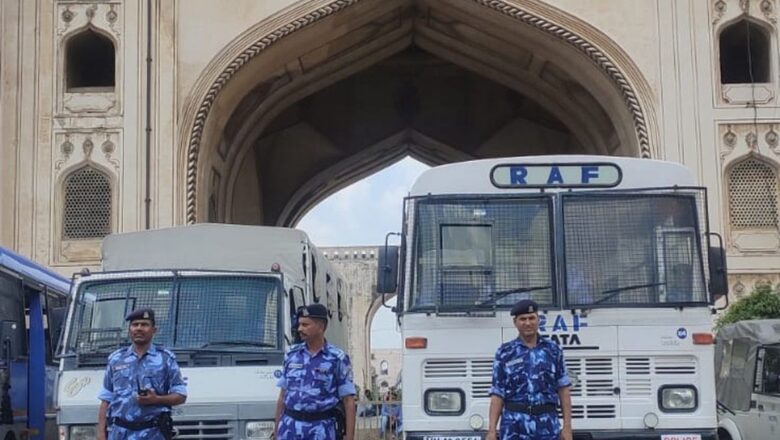
views
September 17, the day the erstwhile princely state of Hyderabad was annexed by India, has opened the floodgates for political parties to peddle their own ideas of marking it. While the BJP, which is making all-out efforts to woo Telangana voters, has announced it to be the “Hyderabad Liberation Day”, the ruling TRS is going with the moniker “Hyderabad National Integration Day”. The saffron party sees it as a day when people, particularly Hindus, were liberated from the tyranny of Nizams and Razakars, the paramilitary force maintained by the Majlis-e-Ittehadul Muslimeen (MIM) party.
Speaking to News18, RSS ideologue and journalist Raka Sudhakar Rao said: “Most narratives miss out on the struggle that people of Telangana waged against the Nizam’s rule and the atrocities of the Razakars. They look at the issue on the basis of texts written by historians like Ramachandra Guha. There is a large body of literature available in both Telugu and English about the war waged by the people against Nizams and Razakars. There is also a misconception that the Nizams were benevolent but the Razakars were fanatics. The Nizams had, in fact, banned public bhajans and processions. You had to take permission from the Nizam to conduct marriages. Teaching in any language other than Urdu was banned.”
However, the Sunderlal Report, which was commissioned after the conclusion of the violent Operation Polo through which Hyderabad state was annexed, had mentioned that 40,000-2,00,000 Muslims were killed. N Venugopal, editor of Veekshanam magazine, says that the events leading to September 17 could not be viewed with the binary lens of Hindus vs Muslims. “The police action was not only against the atrocities of Razakars, but it was also against communists who were waging a war against feudal lords. Though the Nizams believed in Islam, their rule was based on Hindu landlords who had amassed huge acres of land. Together, they served the so-called Christian British empire,” he said. In his book, The Integration of Indian States, VP Menon stated that though the atrocities of Razakars were the primary reason for police action, the burgeoning power of communists too was a major factor.
Fight against feudalism and caste oppression
Venugopal traces the start of the struggle for Telugu identity to 1901 when the first Telugu library was founded. Andhra Jana Sangham was formed in 1921. They, however, slowly realised that it was not only about language and culture but also about who the rulers are. This is why they formed the Andhra Mahasabha in 1931 to address broader issues like land ownership. The communists entered Hyderabad state in 1939 and their party had five members: four Muslims and one Hindu. It included the famous Hyderabadi poet Makhdoom Mohiuddin.
At that time, there was a system called Vethi through which the feudal lords forced peasants from all castes to work for free. While the Brahmins cooked, made leaf plates, took care of rituals, the Dalits worked in the fields. This is the main issue that the Mahasabha (known as sangam in villages) took up while also opposing unequal landholdings. In 1946, a landlord’s henchman killed one protester at a rally in the erstwhile Nalgonda district. After this incident, Andhra Mahasabha and the Communist Party decided to start an armed struggle against the feudal lords. By 1948, this struggle had spread to 3,000 villages in Telangana. Lands were taken back from landlords and were ruled by people’s councils.
Fall of Hyderabad
“In November 1947, the Centre had signed a standstill agreement with Hyderabad. As part of the agreement, the Indian government had agreed never to interfere in the administration of the Nizam state, but by February 1948, they had changed their mind. They introduced the paper in Parliament, which talked about Razakars being a threat,” said Venugopal.
This made the last Nizam, Mir Osman Ali Khan, write to the UN Security Council for protection from the Indian state. Though the Nizam state was not a member of the Council, they took up the matter as the state was supported by members like Pakistan and Argentina. The Indian government did not like this development and was waiting for a window to make its move. The opportunity soon came when Muhammad Ali Jinnah passed away in September 1948.
In the same month, the Indian government took the decision to move military forces against Hyderabad because it was sure that Pakistan would not counterattack since it was in mourning. Though it was a military attack, it was called police action to give the impression that it was an internal matter. The police action was called Operation Caterpillar or Operation Polo. On the morning of September 13, the forces captured Naldurg Fort on the way from Solapur to Hyderabad. Then they attacked Hyderabad from four sides for five days. The city finally fell.
“At that time no newspaper called the event a liberation day. All media including International and local ones called it either invasion of Hyderabad, attack on Hyderabad, fall of Hyderabad, or surrender of Hyderabad. However, two writers called the Vande Mataram brothers wrote a book on the police action and captioned the photos of two army generals as ‘liberators of Hyderabad’. This is when the word was first used,” added Venugopal.
“In 1998, the BJP held a large meeting at the Nizam college grounds. LK Advani, who was the home minister at that time, called the event ’50 years of liberation’. Since that time, the BJP has been insisting that the day should be called Liberation Day. The TRS, which came into the picture in 2001, called the day ‘Betrayal Day’ to stoke up sentiments against people from Andhra. However, now, they have decided to go with ‘National Integration Day’ along with their ally MIM,” he said.
Bias against Hindus
Rao says that there is a good reason that the day is being observed as Liberation Day by the BJP. “The Razakars had the blessings of the Nizams. The Nizams’ closest ally, Bahadur Yar Jung, founded MIM. Owaisi and Kashim Rizvi came much later. Local people rebelled against the linguistic oppression, religious oppression, and bias in employment opportunities. In a few jobs, Hindus could not be promoted beyond a certain point. There are examples of Maharaja Kishan Prasad and Chandulal who became prime ministers during Nizam rule, but it was during the reign of the 5th and 6th Nizam. Mahboob Ali Khan treated all religions equally and was a true Mahboob of the people,” he said.
The 7th Nizam, Osman Ali Khan, was a bigot, added Rao. “He brought Muslims from other parts of the country to change the demography of Hyderabad. The struggle of the locals continued and they formed the Hyderabad State Congress. It was founded by Swami Ramananda Tirtha. They independently fought against the tyranny of the Nizam. While Gandhi sided with the Nizam, the Congress in Hyderabad fought against them. Another movement called Bhagyanagar Satyagraha was led by the Arya Samaj. The fight for civil liberties had started much before the atrocities by the Razakars started. The Hindu Mahasabha also started the Bhagyanagar Satyagraha. Thus, Operation Polo can be called liberation for Hindus from the tyranny of the Nizams and Razakars. Since this view is being endorsed by the BJP today, many are questioning it. But PV Narasimha Rao believed it was liberation, and so did Sardar Vallabhbhai Patel,” he said.
Read all the Latest News India and Breaking News here
















Comments
0 comment